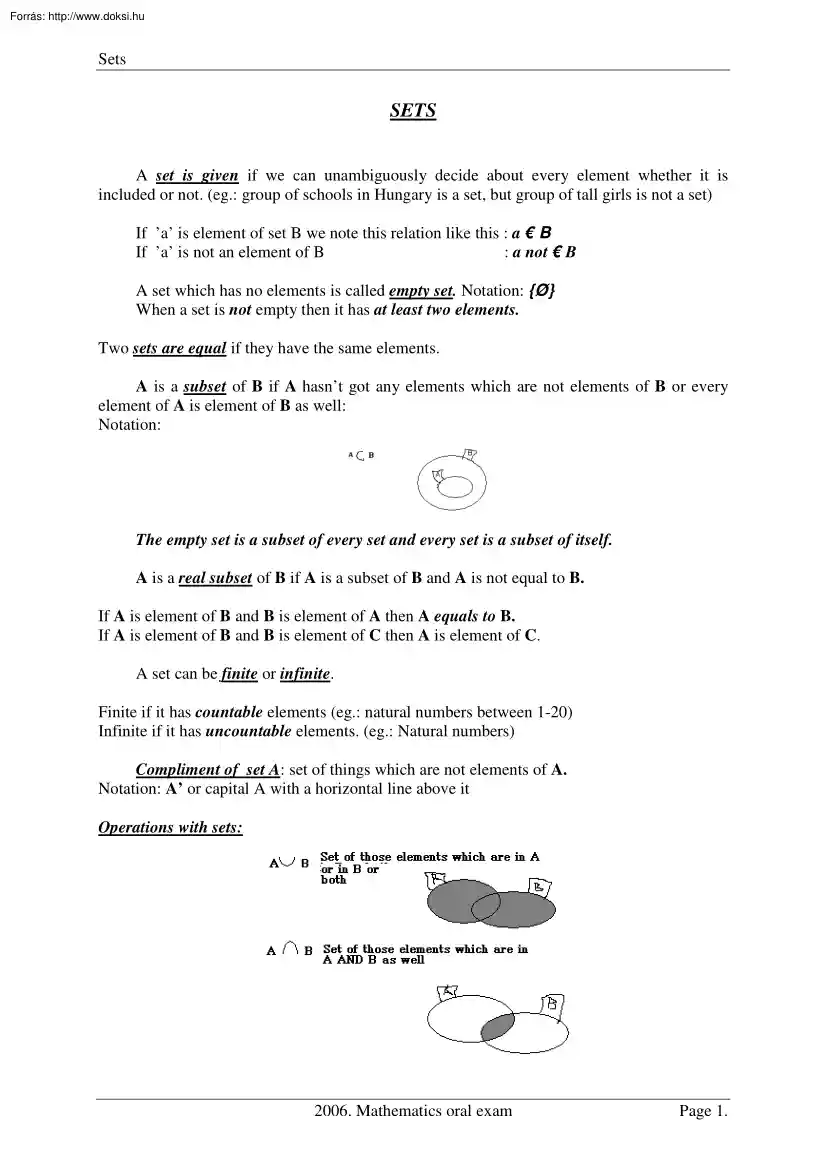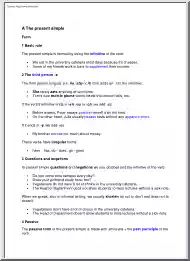Datasheet
Year, pagecount:2008, 3 page(s)
Language:English
Downloads:44
Uploaded:October 26, 2008
Size:26 KB
Institution:
-
Comments:
Attachment:-
Download in PDF:Please log in!
Comments
No comments yet. You can be the first!
What did others read after this?
Content extract
Sets SETS A set is given if we can unambiguously decide about every element whether it is included or not. (eg: group of schools in Hungary is a set, but group of tall girls is not a set) If ’a’ is element of set B we note this relation like this : a € B If ’a’ is not an element of B : a not € B A set which has no elements is called empty set. Notation: {Ø} When a set is not empty then it has at least two elements. Two sets are equal if they have the same elements. A is a subset of B if A hasn’t got any elements which are not elements of B or every element of A is element of B as well: Notation: The empty set is a subset of every set and every set is a subset of itself. A is a real subset of B if A is a subset of B and A is not equal to B. If A is element of B and B is element of A then A equals to B. If A is element of B and B is element of C then A is element of C. A set can be finite or infinite. Finite if it has countable elements (eg.: natural numbers between
1-20) Infinite if it has uncountable elements. (eg: Natural numbers) Compliment of set A: set of things which are not elements of A. Notation: A’ or capital A with a horizontal line above it Operations with sets: 2006. Mathematics oral exam Page 1. Sets AUØ=A AUB=BUA (A U B) U C = A U (B U C) Ø=Ø A B=B A (A B) A C=A (B C) The difference of set A and set B is the set of those elements which are elements of set A but not elements of set B. Notation: A B DEFINITION: Given a line (h) and a point (F) on the plane, where the point is not the element of the line. Parabola is the set of points on the plane which are equidistant from point F and line h (Point F will be the focus point and line h will be the headline of the parabola) (Picture 1) Construction of the points of the parabola: draw a perpendicular from an optional point of the headline and get point Q. Then construct the perpendicular bisector of FQ and get point P (one element of the parabola) at the
intersection of the perpendicular from Q and the perp. bisector of FQ. FP equals to FQ (by def) Repeat this construction to get all points of the parabola. (Picture 2) Picture 1 Picture 2 THEOREM 1 The perpendicular bisectors of a triangle intersect each other in one point (which point is the centre of the circumscribed circle of the triangle) Proof: let K be the intersection point of perp. bisectors of AC and AB Suppose that AC is not parallel to AB, then point K exists. K is on the perp. bisector of AB therefore AK = KB by def K is on the perp. bisector of AC therefore AK = KC by def 2006. Mathematics oral exam Page 2. Sets If AK = KB and AK = KC then KB = KC which means that point K is on the perp.bis of BC as well. Q.ed THEOREM 2 The number of subsets in a set which has n elements is 2n. Proof 1: We can decide about every element if it is in the subset or not - two variations (chosen or not) - decision n times (because the set has n elements) - 2*222.2*22 (n times) = 2n
Proof 2: if the set has n elements we can select subset with 0 elements: in 1 way subset with 1 elements: in n ways subset with 2 elements: in (2 under n) ways subset with 3 elements: in (3 under n) ways subset with k elements: in (k under n) ways (0 under n) + (1 under n) + (2 under n) ++ (n under n)= number of subsets Adding up the two proofs we get that : (0 under n) + (1 under n) + (2 under n) ++ (n under n)= 2n APPLICATIONS: koordinate geometry (basic set, range) Constructions (eg: triangle, circle) 2006. Mathematics oral exam Page 3
1-20) Infinite if it has uncountable elements. (eg: Natural numbers) Compliment of set A: set of things which are not elements of A. Notation: A’ or capital A with a horizontal line above it Operations with sets: 2006. Mathematics oral exam Page 1. Sets AUØ=A AUB=BUA (A U B) U C = A U (B U C) Ø=Ø A B=B A (A B) A C=A (B C) The difference of set A and set B is the set of those elements which are elements of set A but not elements of set B. Notation: A B DEFINITION: Given a line (h) and a point (F) on the plane, where the point is not the element of the line. Parabola is the set of points on the plane which are equidistant from point F and line h (Point F will be the focus point and line h will be the headline of the parabola) (Picture 1) Construction of the points of the parabola: draw a perpendicular from an optional point of the headline and get point Q. Then construct the perpendicular bisector of FQ and get point P (one element of the parabola) at the
intersection of the perpendicular from Q and the perp. bisector of FQ. FP equals to FQ (by def) Repeat this construction to get all points of the parabola. (Picture 2) Picture 1 Picture 2 THEOREM 1 The perpendicular bisectors of a triangle intersect each other in one point (which point is the centre of the circumscribed circle of the triangle) Proof: let K be the intersection point of perp. bisectors of AC and AB Suppose that AC is not parallel to AB, then point K exists. K is on the perp. bisector of AB therefore AK = KB by def K is on the perp. bisector of AC therefore AK = KC by def 2006. Mathematics oral exam Page 2. Sets If AK = KB and AK = KC then KB = KC which means that point K is on the perp.bis of BC as well. Q.ed THEOREM 2 The number of subsets in a set which has n elements is 2n. Proof 1: We can decide about every element if it is in the subset or not - two variations (chosen or not) - decision n times (because the set has n elements) - 2*222.2*22 (n times) = 2n
Proof 2: if the set has n elements we can select subset with 0 elements: in 1 way subset with 1 elements: in n ways subset with 2 elements: in (2 under n) ways subset with 3 elements: in (3 under n) ways subset with k elements: in (k under n) ways (0 under n) + (1 under n) + (2 under n) ++ (n under n)= number of subsets Adding up the two proofs we get that : (0 under n) + (1 under n) + (2 under n) ++ (n under n)= 2n APPLICATIONS: koordinate geometry (basic set, range) Constructions (eg: triangle, circle) 2006. Mathematics oral exam Page 3



 Just like you draw up a plan when you’re going to war, building a house, or even going on vacation, you need to draw up a plan for your business. This tutorial will help you to clearly see where you are and make it possible to understand where you’re going.
Just like you draw up a plan when you’re going to war, building a house, or even going on vacation, you need to draw up a plan for your business. This tutorial will help you to clearly see where you are and make it possible to understand where you’re going.